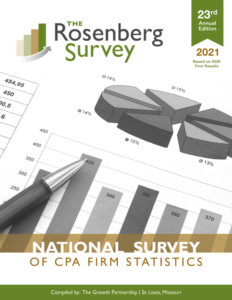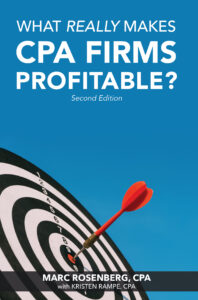2021 Rosenberg MAP Survey: Major Findings “What Pandemic?”
![]() Marc Rosenberg, CPA / Oct 10, 2021
Marc Rosenberg, CPA / Oct 10, 2021
Overview
Three months into the pandemic in 2020, the vast majority of firms projected revenue and profit reductions and staff layoffs. Fortunately, this fear was unfounded. Not only did declines not happen but revenues and profits increased as unveiled in the newly released 23rd annual edition of The Rosenberg MAP Survey. And there were virtually no staff layoffs or cuts in partners’ draws.
We were particularly interested in this year’s survey results because for the first time anywhere, we were able to examine, analyze and publish the true impact of the pandemic on the CPA profession. As many would expect, the findings of the survey are quite remarkable.
Specifics
1. Revenues rose.
Up 5.7% from last year, the lowest since 5.4% in 2012 but fantastic considering the pandemic. In the recession of 2008-09, a client of mine coined the phrase “flat is up,” meaning that if CPA firms could remain even, that would be a major win because most businesses were suffering from catastrophic revenue and profit declines.
In most years, rate increases account for 20-30% of revenue gains. But in 2020, firms didn’t increase their rates much at all.
- Equity partner billing rates, considered a barometer of firms’ overall rates, averaged $344, largely unchanged from $340 in the prior year.
- The industry’s overall firm billing rate was $160.03 compared to $159.10, essentially unchanged.
2. Mergers keep on ticking. Most industries rarely differentiate organic from merger growth. But CPA firms are keen on differentiating the two, almost as if merger growth doesn’t count. In 2020, mergers fueled 23% of the CPA firms’ revenue growth, about the same as its been the past few years. Anecdotally, we sense an uptick in merger activity in 2021 as many firms who deferred M&A during the onset of the pandemic are now pursuing it vigorously.
3. Lower expenses. For the first time in the history of our survey, overhead spending (all costs except those for labor) was lower than in the prior year: $39,172 per person or 8.7% lower than in 2019, undoubtedly the result of firms hunkering down and simply having less to spend on.
4. Profits up! Income per equity partner (IPP), the CPA industry’s somewhat flawed but most- often used measure of profitability, was up. And in a pandemic yet! Overall, IPP was up 5.0% from last year, an amazing feat considering the uncertain times we are in. This increase was attributable to organic revenue growth and lower overhead spending. IPP crossed the $500,000 mark (for multi-partner firms over $2M) for the first time in our profession, finishing at an amazing $521,000 per equity partner. Most partners never dreamed they would earn this much when they began learning about debits and credits in college. Note that income from PPP loans forgiven, which will be quite substantial, will mostly impact 2021 income, not 2020.
5. IT expenditures up. Given the dramatically increased emphasis in and reliance on technology, IT expenses increased to 4.9% of revenue from 4.6% of revenue, the sharpest increase in quite some time. Clearly, with the shift from personnel working in the office to mostly remote, firms have invested in technology to make this shift as seamless and efficient as possible. And it worked! Remote work was instantly transformed from a perk to a necessity. Huge investments were made in video collaboration tools, the Cloud and remote audit.
The Rosenberg Survey has been the gold standard for benchmarking CPA firms for over 20 years. Accounting Today calls it the “industry’s barometer for CPA firm practice management.”
6. Remote work is here to stay. Prior to the pandemic, roughly 15% of CPA firms’ work was performed remotely. That obviously increased to nearly 100% for many months. Our polling of firms indicates that firms don’t ever expect to return to anything close to pre-pandemic norms. At a minimum, firms are projecting something in the 35% range, but this figure is highly susceptible to the taming of the virus and its variants, getting herd immunity regarding vaccinations, uncertainly regarding how long the pandemic will last and continually changing attitudes towards remote work (attitudes of firms and what staff are demanding).
7. Flattened staff-partner ratio. This metric has been steadily increasing for many years due to firms raising the bar for promotion to equity partner coupled with their enhanced understanding of the strong link between leveraging staff and profitability. But this trend stopped right in its tracks in 2020, remaining exactly where it was at in the prior year – 6.7:1. This was due to the general uncertainty caused by the pandemic, resulting in firms curtailing their recruiting until their business began stabilizing. This despite firms’ continuing struggles to find and retain good people to support their revenue increases.
8. Staff turnover down. Whenever there is major disruption in the world, CPA firm staff tend to stay put instead look for new jobs. We’ve seen this repeatedly in recessions and we have clearly seen this in the pandemic. Professional staff turnover in 2020 was 15.3%, 12% lower than the previous year. But industry pundits are saying (and we agree with them) that at some point soon, staff are going to wake up and make job changes in droves. CPA firms: beware!
9. Consulting boom? We don’t see it. In perhaps the biggest divergence between what the CPA industry expects but has yet to experience, consulting revenues have not increased, holding steady at about 14% of total revenue. But given the expected technology advances in compliance services coupled with clients’ increased demand for consulting, it’s only a matter of time until consulting revenue ticks up. We attribute the flat consulting revenues to local firms’ (the bulk of firms in our survey) overall slowness in adapting to change, demand for compliance work continuing to be strong and again, the shock of enduring this life-altering pandemic that shows no signs of ending.
10. Audit-heavy firms struggle with profitability. Firms that perform a high amount of audit work saw their profits continue to lag behind those doing a low number of audits, as has been the case throughout our survey’s history. The audit industry has always been more subject to lower profits due to heavier price competition than in other service areas. Our surveys have consistently shown that firms with the lowest reliance on audits post the highest IPP. But in 2020, this profit gap widened considerably. Firms in the lowest quartile in terms of audit dependence (their audit revenue was 9% of total revenue) posted IPP that was 30% higher than the middle 50% group (whose audit revenue was 26% of total revenue).
Which of the trends above were true for your firm? Any significant divergences?

What Really Makes CPA Firms Profitable?, Second Edition
New Second Edition! Several dozen high-impact techniques for maximizing profitability; 25 best practices for moving firms from good to great; what is NOT important to profitability; BONUS: current CPA industry benchmarks from The Rosenberg MAP Survey.
Learn More